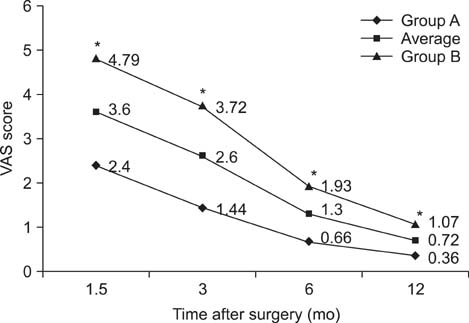Clin Orthop Surg.
2014 Dec;6(4):392-400. 10.4055/cios.2014.6.4.392.
The Factors Affecting Pain Pattern after Arthroscopic Rotator Cuff Repair
- Affiliations
-
- 1Department of Orthopaedic Surgery, Inje University Busan Paik Hospital, Inje University College of Medicine, Busan, Korea. kimjunghan74@gmail.com
- KMID: 1794726
- DOI: http://doi.org/10.4055/cios.2014.6.4.392
Abstract
- BACKGROUND
We evaluated the factors that affect pain pattern after arthroscopic rotator cuff repair.
METHODS
From June 2009 to October 2010, 210 patients underwent arthroscopic rotator cuff repair operations. Of them, 84 patients were enrolled as subjects of the present study. The evaluation of postoperative pain was conducted by visual analog scale (VAS) scores during postoperative outpatient interviews at 6 weeks, 3 months, 6 months, and 12 months. The factors that were thought to affect postoperative pain were evaluated by dividing into three categories: preoperative, operative, and postoperative.
RESULTS
Pain after arthroscopic rotator cuff repair surgery showed a strictly decreasing pain pattern. In single analysis and multiple regression tests for factors influencing the strictly decreasing pain pattern, initial VAS and pain onset were shown to be statistically significant factors (p = 0.012, 0.012, 0.044 and 0.028, respectively). With regard to the factors influencing lower than average intensity pain pattern for each period, the stiffness of internal rotation at 3 months postoperatively was shown to be a statistically significant factor in single and multiple regression tests (p = 0.017 and p = 0.004, respectively).
CONCLUSIONS
High initial VAS scores and the acute onset of pain affected the strictly decreasing postoperative pain pattern. Additionally, stiffness of internal rotation at postoperative 3 months affected the higher than average intensity pain pattern for each period after arthroscopic rotator cuff repair.
MeSH Terms
Figure
Reference
-
1. Iannotti JP. Full-thickness rotator cuff tears: factors affecting surgical outcome. J Am Acad Orthop Surg. 1994; 2(2):87–95.2. Brislin KJ, Field LD, Savoie FH 3rd. Complications after arthroscopic rotator cuff repair. Arthroscopy. 2007; 23(2):124–128.3. Bishop JY, Sprague M, Gelber J, et al. Interscalene regional anesthesia for shoulder surgery. J Bone Joint Surg Am. 2005; 87(5):974–979.4. Boss AP, Maurer T, Seiler S, Aeschbach A, Hintermann B, Strebel S. Continuous subacromial bupivacaine infusion for postoperative analgesia after open acromioplasty and rotator cuff repair: preliminary results. J Shoulder Elbow Surg. 2004; 13(6):630–634.5. Cho CH, Song KS, Min BW, et al. Multimodal approach to postoperative pain control in patients undergoing rotator cuff repair. Knee Surg Sports Traumatol Arthrosc. 2011; 19(10):1744–1748.6. Cho NS, Ha JH, Rhee YG. Patient-controlled analgesia after arthroscopic rotator cuff repair: subacromial catheter versus intravenous injection. Am J Sports Med. 2007; 35(1):75–79.7. Jaureguito JW, Wilcox JF, Cohn SJ, Thisted RA, Reider B. A comparison of intraarticular morphine and bupivacaine for pain control after outpatient knee arthroscopy: a prospective, randomized, double-blinded study. Am J Sports Med. 1995; 23(3):350–353.8. Oh JH, Kim WS, Kim JY, Gong HS, Rhee KY. Continuous intralesional infusion combined with interscalene block was effective for postoperative analgesia after arthroscopic shoulder surgery. J Shoulder Elbow Surg. 2007; 16(3):295–299.9. Ritchie ED, Tong D, Chung F, Norris AM, Miniaci A, Vairavanathan SD. Suprascapular nerve block for postoperative pain relief in arthroscopic shoulder surgery: a new modality? Anesth Analg. 1997; 84(6):1306–1312.10. Scoggin JF 3rd, Mayfield G, Awaya DJ, Pi M, Prentiss J, Takahashi J. Subacromial and intra-articular morphine versus bupivacaine after shoulder arthroscopy. Arthroscopy. 2002; 18(5):464–468.11. Takada M, Fukusaki M, Terao Y, et al. Postoperative analgesic effect of preoperative intravenous flurbiprofen in arthroscopic rotator cuff repair. J Anesth. 2009; 23(4):500–503.12. Tetzlaff JE, Brems J, Dilger J. Intraarticular morphine and bupivacaine reduces postoperative pain after rotator cuff repair. Reg Anesth Pain Med. 2000; 25(6):611–614.13. Burns JW, Hodsman NB, McLintock TT, Gillies GW, Kenny GN, McArdle CS. The influence of patient characteristics on the requirements for postoperative analgesia: a reassessment using patient-controlled analgesia. Anaesthesia. 1989; 44(1):2–6.14. Scott J, Huskisson EC. Graphic representation of pain. Pain. 1976; 2(2):175–184.15. Stiglitz Y, Gosselin O, Sedaghatian J, Sirveaux F, Mole D. Pain after shoulder arthroscopy: a prospective study on 231 cases. Orthop Traumatol Surg Res. 2011; 97(3):260–266.16. Desai VN, Cheung EV. Postoperative pain associated with orthopedic shoulder and elbow surgery: a prospective study. J Shoulder Elbow Surg. 2012; 21(4):441–450.17. Kuijpers T, van der Windt DA, van der Heijden GJ, Bouter LM. Systematic review of prognostic cohort studies on shoulder disorders. Pain. 2004; 109(3):420–431.18. Koo SS, Parsley BK, Burkhart SS, Schoolfield JD. Reduction of postoperative stiffness after arthroscopic rotator cuff repair: results of a customized physical therapy regimen based on risk factors for stiffness. Arthroscopy. 2011; 27(2):155–160.19. Oh JH, Kim SH, Lee HK, Jo KH, Bin SW, Gong HS. Moderate preoperative shoulder stiffness does not alter the clinical outcome of rotator cuff repair with arthroscopic release and manipulation. Arthroscopy. 2008; 24(9):983–991.20. Papalia R, Franceschi F, Vasta S, Gallo A, Maffulli N, Denaro V. Shoulder stiffness and rotator cuff repair. Br Med Bull. 2012; 104(1):163–174.21. Tauro JC. Stiffness and rotator cuff tears: incidence, arthroscopic findings, and treatment results. Arthroscopy. 2006; 22(6):581–586.22. Huberty DP, Schoolfield JD, Brady PC, Vadala AP, Arrigoni P, Burkhart SS. Incidence and treatment of postoperative stiffness following arthroscopic rotator cuff repair. Arthroscopy. 2009; 25(8):880–890.23. Namdari S, Green A. Range of motion limitation after rotator cuff repair. J Shoulder Elbow Surg. 2010; 19(2):290–296.24. Franceschi F, Longo UG, Ruzzini L, et al. Circulating substance P levels and shoulder joint contracture after arthroscopic repair of the rotator cuff. Br J Sports Med. 2008; 42(9):742–745.
- Full Text Links
- Actions
-
Cited
- CITED
-
- Close
- Share
- Similar articles
-
- Revisional Rotator Cuff Repair
- New Retear Pattern after Rotator Cuff Repair at Previous Intact Portion of Rotator Cuff
- Various Regimens for the Functional Recovery after Arthroscopic Shoulder Surgery
- Postoperative Ultrasound Findings of the Rotator Cuff Tendon after Arthroscopic Repair of a Rotator Cuff Tear
- Surgical treatment for rotator cuff tears: the way it ought to be



